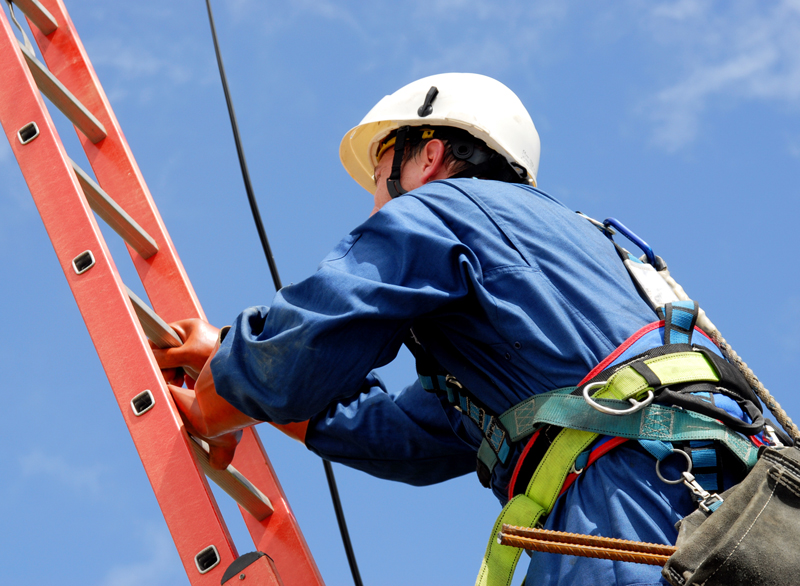The HSE recently published the 2023/24 reports stating there were 138 work-related fatal injuries and highlighted that working at height remains the lead cause of fatal injuries at work. These figures have grown compared to previous years from 37 deaths to 50 deaths in 2023/24, are a stark reminder that work activities that involve working at height should be carefully planned and regularly assessed. Below, we’ve answered the key questions employers need to know before undertaking any working at height activity.
At SafeWorkforce, our team of experts is dedicated to ensuring your business stays safe by providing tailored advice and documentation that comply with current legislation. If you need support with working at height, our consultants can review and update your documentation, and conduct site visits to ensure health and safety best practices are always implemented.
What is the definition of working at height?
Working from height is any task that involves a risk of falling which could lead to a injury. This includes work on ladders, scaffolds, roofs, platforms, or on a fragile surface.
What regulations apply to working from height in the UK?
The primary regulation is the Work at Height Regulations 2005, which outlines the legal responsibility of all employers and anyone responsible for working at height activities.
Other relevant regulations include the Health and Safety at Work etc. Act 1974 and the Construction (Design and Management) Regulations 2015 (CDM).
What duties do employers have under the Work at Height Regulations 2005?
- Must do all that is reasonably practicable to prevent anyone falling.
- Properly plan and organise work at height.
- Conduct risk assessments.
- Ensure all work at height takes account of weather conditions that could endanger health and safety;
- Ensure workers are competent and trained.
- Provide appropriate equipment.
- Implement measures that will minimise the risk of potential falls.
- Regularly inspect and maintain equipment.
What are the risks for your business when there’s a working at height accident?
- Accidents and fatal injuries: Working at height is the leading cause of fatal injuries in the UK. The HSE reports that injuries from falls are estimated to be around 35,000, up from approximately 25,000 in the previous period.
- Employee absences and loss of work: An accident can result in both short-term and long-term employee absences, leading to a significant loss of productivity and work.
- Fines and prosecution: Non-compliance with the Work at Height Regulations 2005 can result in HSE prosecution and civil litigation. For example, a small business was recently fined £40,000 after an employee fell from a height and sustained a serious injury.
- Reputational damage: The HSE publishes details of fines and prosecutions on their website, which can harm your business’s reputation.
Addressing these risks proactively when working at height is unavoidable. The Hierarchy of Control Measures, can be used to determine which measures should be prioritised. is essential for the safety and well-being of your employees and the continued success of your business.
What is the role of a risk assessment when working at height?
Considering the risks related with work at height and putting in place sensible and proportionate measures to manage them is an important part of working safely.
The working at height regulations states that all efforts must be taken to avoid work activities that involves working at height. It may be possible to complete the task using extendable tools or by lowering an object to the ground before commencing work. Therefore, whenever possible, work should be conducted at ground level.
If the work at height can not be avoided then the Employers and those in control (Duty Holders) must first assess the risks.
A risk assessment identifies potential hazards and assesses the risks associated with working at height. It helps in implementing control measures to prevent falls and other injuries.
When you begin a working at height risk assessments, here are examples of how to identify the hazards and assess the severity of the risk.
Identify the working at height task
- Highlight the activity: you’ll need to identify the task involved, such as painting, cleaning, maintenance or installation.
- Activity location: specify the location of the activity, such as roofs, scaffolds, ladders or elevated platforms.
- Height of the task,
- The duration of the task,
- The condition of the surface being worked on
- The frequency of the task.
Identify the hazards
- Physical hazards: before each task is complete you have a legal obligation to identify the potential hazards, such as unstable surfaces unguarded edges, weather conditions, electrical sources, selection of incorrect equipment or faulty equipment.
- Human factors: it can be easy to overlook the human element before starting a task, therefore it’s imperative to consider aspects such as fatigue, experience and training when outlining potential hazards.
- Environmental conditions: when working at height outdoors, environmental factors such as wind, rain or extreme temperatures should always be considered before starting an activity.
Assess the risk
After you’ve identified the potential hazards, your next step will be evaluating the risks
- Step one: Determine the consequences: here you will outline the severity of potential injury and decide who may be harmed resulting from the identified hazards.
- Step two: Probability: next you’ll need to assess the likelihood of the hazard causing an incident.
- Step three: Risk rating: Evaluate the risks by combining the severity and likelihood to rate the risk (e.g. high, medium, low) and decide on precautions
- Step four: Record your findings and implement them
- Step five: Review and revise your risk assessment if necessary (usually after an event or change)
What training is required for working at height?
We would always recommend that any new employees receive training during the onboarding process before completing any working at height task, and training should be reviewed on an annual basis including exiting employees.
- Safe working practices for common forms of access equipment i.e ladders and scaffolds.
- Fall prevention and protection.
- Correct use of personal protective equipment (PPE).
- Emergency procedures.
- Understanding legal obligations including an overview of the relevant regulations.
- An overview of working activities involving risk of injury from working at height and typical injuries
- Inspection requirements for scaffolds.
What are the safe use guidelines for ladders?
Please note: if your task would require staying up a leaning ladder or stepladder for more than 30 minutes at a time, it is recommended you use alternative equipment. However, short duration is not the deciding factor, the task must be assessed and the correct equipment provided for use
- Inspect ladders before use.
- Ensure they are suitable for the task.
- Place ladders on stable, level surfaces.
- Maintain three points of contact.
- Do not overreach.
- Use ladders only for short-duration tasks.
What are the safety requirements for using scaffolds?
- Scaffolds must be erected, used, and dismantled by competent persons.
- Ensure stability and security.
- Use guardrails and toe boards.
- Conduct regular inspections, especially after adverse weather conditions.
- Do not overload scaffolds.
How can falls be prevented when working at height?
- Use working platforms include scaffolding, mobile towers and mobile elevating work platforms (MEWPs).
- Use fall arrest/restraint systems where necessary.
- Keep work areas tidy to prevent slips and trips.
- Install guardrails on platforms.
- Ensure adequate lighting.
- Plan the work to avoid overreaching.
What should be included in an emergency plan when working at height?
A. Your rescue plan in case of a fall should include:
- The safety of all individuals carrying out the rescue
- Information about the anchor points for the safety equipment
- The suitability of any equipment
- How the individual will be attached to the rescue equipment
- How the individual will be moved using the rescue equipment
- Information about any medical needs or other needs of the individuals involved in the rescue
B. Clear emergency procedures
C. Accessible first aid kits
D. Effective means of communication to call for help
What personal protective equipment (PPE) is necessary when working at height?
- Hard hats.
- Non-slip footwear.
- Fall arrest/restraint systems (harnesses, lanyards).
- High-visibility clothing where necessary.
What are the specific considerations for working indoors vs. outdoors?
- Indoors: Ensure proper ventilation when using paints and chemicals, manage indoor hazards like electrical cords.
- Outdoors: Consider weather conditions, use sun protection, and be aware of risks from working near traffic or exposed areas.
Do you need supervision when completing a working at height activity?
Completing working at height activities alone increases the risk of injury, therefore we would always recommend supervision when completing a working at height activity. Supervision provides additional security measures for your business, along with:
- Ensuring compliance with safety protocols.
- Identifies and mitigates potential hazards.
- Provides guidance and support to less experienced workers.
What are common mistakes when working at height?
- Skipping equipment inspections.
- Improper ladder use (e.g., using damaged ladders, overreaching).
- Failing to use fall protection.
- Neglecting to secure tools and materials that could fall.
Following the release of the latest HSE statistics, which clearly demonstrate that working at height remains the leading cause of fatal injuries, it’s more crucial than ever to be proactive in your health and safety management.
If you need support to ensure your business maintains safe working practices, the team of experts at SafeWorkforce is here to help. Here’s a snapshot of the support we can provide:
- Process review: We’ll review your current working at height procedures, offering advice on reducing risks and specifying the necessary PPE.
- Tailored risk assessments: We can review and advise in creating customized risk assessments for working at height activity your team undertakes.
- Toolbox talks: Our range of toolbox talks will help upskill your employees, ensuring they are well-informed and prepared.
- Accident response: In the event of an accident, we provide guidance on implementing effective remedial actions.
With SafeWorkforce by your side, you can ensure that your team stays safe while working at height.


